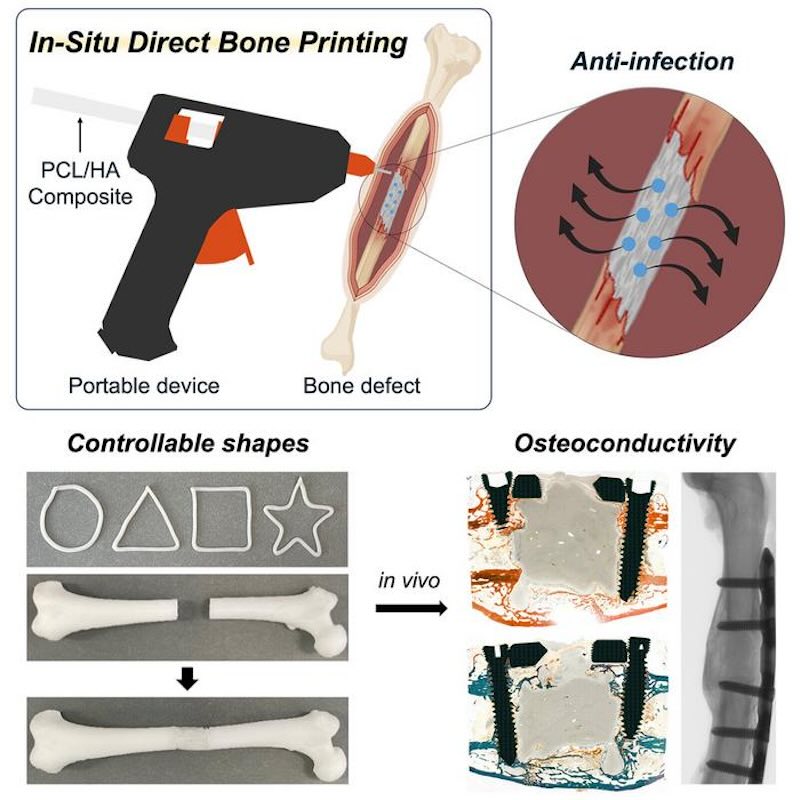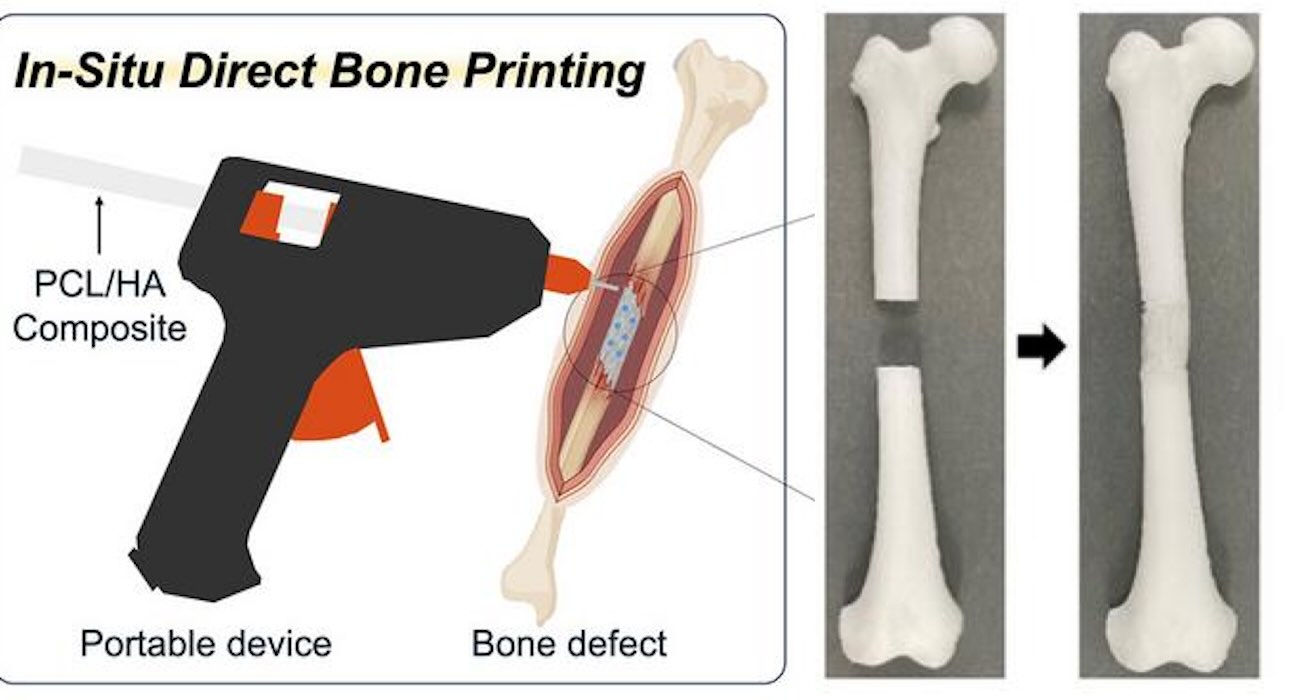
A new 3D printing “glue gun” can generate bone grafts directly onto fractures, using a revolutionary process that can fill-in the gaps around the site’s jagged edges.
Now, the researchers in South Korea are preparing for human trials, having developed a tool made from a modified glue gun that can 3D-print bone grafts to repair defects during surgery.
Essentially, it quickly creates bone implants on the spot, without the need for making them in advance.
The researchers “optimized” the 3D-printed grafts until they exhibited high structural flexibility while releasing anti-inflammatory antibiotics and promoting natural bone regrowth at the grafting site—conforming to the jagged edges of a fracture.
Bone implants have previously been made of metal or donor bone or, more recently, 3D-printed material. But in cases involving more complex fractures the implants must be designed and produced prior to surgery to allow for appropriate fitting.
So, the scientists developed a new technology that offers a distinct approach: a printing system for use directly at the surgical site, that enables a “real-time fabrication and application of a scaffold,” said study co-author Professor Jung Seung Lee, of Sungkyunkwan University in South Korea.
“This allows for highly accurate anatomical matching even in irregular or complex defects without the need for preoperative preparation such as imaging, modeling, and trimming processes.”
What’s in the ‘glue’?
He explained that the material fed into the glue gun is a filament comprised of two major components: a feature of natural bone known to promote healing called hydroxyapatite (HA) and a biocompatible thermoplastic called polycaprolactone (PCL).
PCL can liquify in temperatures as low as 60 Celsius, which when applied with a heat-modified glue gun, is cool enough to prevent tissue damage during surgical application while being able to conform to the jagged grooves of fractured bone.
BRILLIANT: Scientists Are 3D-Printing Stem Cells that Can Be Implanted as Brain Tissue
By adjusting the proportion of HA to PCL within the filament, the researchers can customize the hardness and strength of the grafts to fit different anatomical needs.
“Because the device is compact and manually operated, the surgeon can adjust the printing direction, angle, and depth during the procedure in real time,” said Prof. Lee.
“Also, we demonstrated that this process could be completed in a matter of minutes.
“This highlights a significant advantage in terms of reducing operative time and improving procedural efficiency under real surgical conditions.”
Since infection is a common concern with surgical implants, the researchers incorporated vancomycin and gentamicin, two anti-bacterial compounds, into the filament.
The research, published in the journal Device, showed, in both petri dish culture and liquid medium, the filament scaffold successfully inhibited the growth of E. coli and S. aureas, two common bacteria prone to cause post-surgery infections.
Due to physical properties of HA and PCL within the filament, the drugs are released slowly and are able to diffuse directly onto the surgical site over several weeks.
AMAZING! Woman Given New 3D-Printed Windpipe in World First
Prof Lee said: “This localized delivery approach offers meaningful clinical advantages over systemic antibiotic administration by potentially reducing side effects and limiting the development of antibiotic resistance, while still effectively protecting against postoperative infection.”
As a proof of concept, the device was tested on the severe femoral bone fractures in rabbits, with huge success.
Within 12 weeks of surgery, the team found no signs of infection or necrosis and greater bone regeneration when compared to rabbits grafted with bone cement—a sealing compound commonly used for treating defects.
“The scaffold was designed not only to integrate biologically with surrounding bone tissue but also to gradually degrade over time and be replaced by newly formed bone.
“The results showed that the printing group exhibited superior outcomes in key structural parameters such as bone surface area, cortical thickness, and polar moment of inertia, suggesting more effective bone healing and integration.”
RELATED GENIUS: New Tool Can 3D Bio-Print Inside Human Body to Construct Natural Tissue-Like Structures
The researchers have now set their sights on optimizing the anti-bacterial potential of the scaffold further, and preparing the procedure for human trials, believing that their approach can become a practical and immediate solution for bone repair directly in the operating room.
BRIDGE THE DISTANCE Between This And 3D-Printing Fans on Social Media…


Leave a Reply